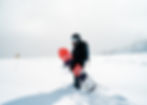Written by a Movement Specialist

Snowboarding can be an exhilarating experience, but the thrill comes with some inherent injury risks. Knowing the different types of injuries associated with snowboarding, what causes them and how to stay safe on the slopes is essential for a fun and safe winter season.
Ankle Sprains
Ankle sprains are a common injury amongst snowboarders, caused by too much pressure being placed on the ankle joint. It usually happens when a snowboarder is off-balance and falls, accidentally twisting the ankle while they’re trying to regain control. To prevent this from happening, snowboarders should make sure that their boots are appropriately tightened and have a good binding system in place. Additionally, wearing an ankle brace and doing regular exercises to strengthen the ankles can help lessen the occurrence of ankle sprains.

ACL Tears or Strains
Snowboarding can put a lot of pressure on the ACL (anterior cruciate ligament) located in the knee joint. Injuries to the ACL may occur if an individual twists their knee suddenly while turning at the bottom of a hill. Preventing such injuries can be done by properly stretching and warming up prior to hitting the slopes and learning how to perform proper turns with good form. Increasing strength in your leg muscles by engaging in exercises regularly also lowers risk for ACL tears or strains. A knee brace is another option, as it provides extra support and protection when recovering from a knee injury or from potential re-injury.
Wrist Fractures or Dislocations
Wrist fractures and dislocations are some of the most common snowboarding injuries. Falling can cause extreme stress to your wrist joints, leading to fractures or dislocation. To prevent snowboarding related wrist injuries, try wearing wrist guards or gloves with padded support for extra cushioning. Additionally, practice proper form when it comes to gripping your board; keeping that grip tight but relaxed will help save you from an unexpected slip and fall on icy slopes.
Shoulder Dislocations
Shoulder dislocations occur with a high frequency of around 12% among snowboarding injuries. This is due to falling on an outstretched arm and having the shoulder joint absorb the majority of force, resulting in the head of the humerous being forced partially (subluxation) or fully out its socket. If a shoulder dislocation has been sustained, it can be prevented in the future by achieving and maintaining good strength and flexibility in muscles surrounding the shoulder joint. Additionally, wearing a shoulder brace that limits range of motion may be beneficial to protect against further injuries when returning to snowboarding.

When it comes to snowboarding, prevention is the best form of treatment. However, if you experience a snowboarding injury, wearing a brace or support can help keep you moving.
They can be used to limit movement of injured joints, reduce swelling, and provide support for healing muscles and ligaments.
Get back to shredding the slopes by visiting a Paris everyBODY location and consulting with one of our Movement Specialists. They will provide insights into your injury and find you a brace or support with the perfect fit, giving you greater comfort so that you can return to hitting the mountains safely!
*always consult your Healthcare Professional for a diagnosis
